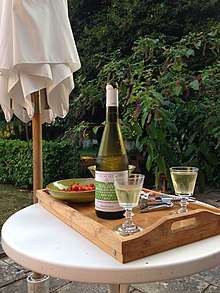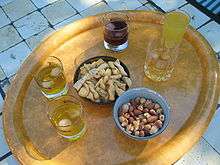Apéritif and digestif
Apéritifs (/əˈpɛrɪtiːf/) and digestifs (/diːʒɛˈstiːf/) are drinks, typically alcoholic, that are normally served before (apéritif) or after (digestif) a meal.

Apéritifs
An apéritif is an alcoholic beverage usually served before a meal to stimulate the appetite, and is therefore usually dry rather than sweet. Common choices for an apéritif are vermouth; champagne; pastis; gin; rakı; fino, amontillado or other styles of dry sherry (but not usually cream or oloroso blended sherry, which is very sweet and rich); and any still, dry, light white wine.
An apéritif may be served with an hors d'oeuvre or amuse-bouche, such as crackers, cheese, pâté, quiche or olives.[1][2]
Apéritif is a French word "derived from the Latin verb aperire, which means to open".[3] The French colloquial word for apéritif is apéro.
History
The 5th-century Christian ascetic Diadochos of Photiki says, "People who wish to discipline the sexual organs should avoid drinking those artificial concoctions which are called 'aperitifs'—presumably because they open a way to the stomach for the vast meal which is to follow." So apéritifs were in use in the 5th century.[4]
In 1796, Turin distiller Antonio Carpano invented modern vermouth.[5][6]
The apéritif was introduced in France in 1846 when a French chemist, Joseph Dubonnet, created his eponymous wine-based drink as a means of delivering malaria-fighting quinine. The medicine was a bitter brew, so he developed a formula of herbs and spices to mask quinine's sharp flavor, and it worked so well that the recipe has remained well-guarded ever since. French Foreign Legion soldiers made use of it in mosquito-infested Northern Africa. Dubonnet's wife was so fond of the drink that she had all her friends try it, and its popularity spread.

Apéritifs were already widespread in the 19th century in Italy, where they were being served in fashionable cafés in Turin (where they were born), Rome, Genoa, Florence, Milan and Venice. Apéritifs became very popular in Europe in the late 19th century. The popularity in Europe crossed the Atlantic and by 1900, they were also commonly served in the United States. The apéritif recrossed the Atlantic in the 1970s: the habit of a substantial food offering with the purchase of a drink during "Happy Hour" in the United States pushed the development of a more food-heavy apéritif in Italy as well.[7] In Spain and in some countries of Latin America, apéritifs have been a staple of tapas for centuries.
Types
There is no single alcoholic drink that is always served as an apéritif. Fortified wine, liqueur, and dry champagne are probably the most common choices. Because it is served before dining, the emphasis is usually on dry rather than sweet, as a general guideline.
- In France, the apéritif varies from region to region: pastis is popular in the south of France, Calvados brandy in the Normandy region, Crémant d'Alsace in the eastern region. Champagne wine or Cognac may also be served. Kir, also called Blanc-cassis, is a common and very popular apéritif-cocktail made with a measure of crème de cassis (blackcurrant liqueur) topped up with white wine like bourgogne aligoté. The word Kir Royal is used when white wine is replaced with a Champagne wine. A simple glass of red wine, such as Beaujolais nouveau, can also be presented as an apéritif, accompanied by amuse-bouches.
- In Italy, vermouth or wine may be served as the apéritif (called aperitivo). Martini, Aperol Spritz and Campari with soda are also popular aperitivo drinks of choice.
- In Greece, ouzo is a popular choice, except on Crete, where it is very common to take some Tsikoudia (raki) after a meal.
- In the Eastern Mediterranean, arak is served with meze.
- In Britain and Ireland sherry and dry madeira are traditional apéritifs.
Digestifs
A digestif is an alcoholic beverage served after a meal, to aid digestion.[8] When served after a coffee course, it may be called pousse-café.[9] Digestifs are usually taken neat.
Common kinds of digestif include:
- Brandy (Cognac, Armagnac, alembic-made)
- Chacha
- Eaux de vie (fruit brandies, Schnapps, Calvados)
- Pomace brandy (grappa)
- Tsikoudia
- Fortified wines (sweet sherry (usually cream or oloroso sherry), vermouth, port, and madeira)
- Liqueurs bitter or sweet (Drambuie, amari (such as fernet), herbal liqueur, Sambuca, Chartreuse, Grand Marnier, Jägermeister, Irish Mist, Kahlúa, limoncello, Herbs de Majorca, Beirão, Unicum, Underberg, Fernet-Branca, Mirto, Malort)
- Distilled liquors (ouzo, tequila or akvavit)
- Liquor cocktails (Black Russian, Rusty Nail, etc.)
Bitter digestifs typically contain carminative herbs, which are thought to aid digestion.[10]
In many countries, people drink alcoholic beverages at lunch and dinner. Studies have found that when food is eaten before drinking alcohol, alcohol absorption is reduced[11] and the rate at which alcohol is eliminated from the blood is increased. The mechanism for the faster alcohol elimination appears to be unrelated to the type of food. The mechanism is likely food-induced, which increases in alcohol-metabolizing enzymes and liver blood flow.[11]
See also
References
- Lichine, Alexis. Alexis Lichine's New Encyclopedia of Wines & Spirits (5th edition) (New York: Alfred A. Knopf, 1987), 75.
- Robinson, Jancis. The Oxford Companion to Wine (3rd edition) (Oxford University Press: 2006), 26.
- "The Why and How Of Serving An Aperitif". Everyday Health. November 15, 2017. Retrieved July 14, 2020.
- The Philokalia: Vol. 1; St. Diadochos of Photiki, On Spiritual Knowledge; p. 267. Faber and Faber, Inc. New York, New York; 1979.
- Bezzone, Francesca (November 12, 2019). "The Old History of the Aperitivo". Life in Italy. Retrieved December 5, 2019.
- Brown & Miller, Jared & Anistatia (2011). The Mixellany Guide to Vermouth & Other Aperitifs. Mixellany Limited. p. 44. ISBN 978-1-907434-29-7.
- "The Italian Aperitivo".
- "Digestif". Dictionary.com Unabridged. Random House. Retrieved 6 March 2015.
- "pousse-café". Dictionary.com Unabridged. Random House. Retrieved 6 March 2015.
- Walton, Stuart; Miller, Norma (2002). Spirits & Liqueurs Cookbook. New York: Hermes House. pp. 16–17. ISBN 1-84309-498-3.
- Ramchandani, V.A.; Kwo, P.Y.; Li, T-K. (2001). "Effect of Food and Food Composition on Alcohol Elimination Rates in Healthy Men and Women". Journal of Clinical Pharmacology. 41 (12): 1345–50. doi:10.1177/00912700122012814. PMID 11762562.